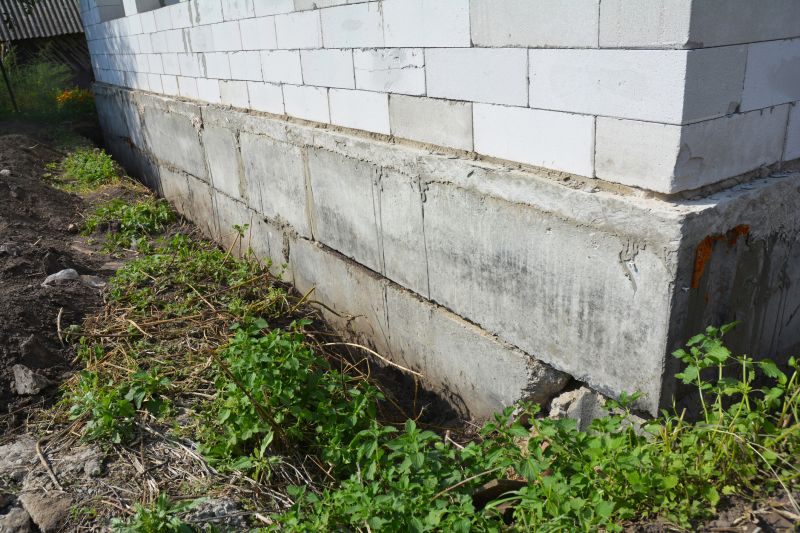Top-Rated Foundation Repair Products For Long-Lasting Stability
Browse durable and proven products that help secure your home's foundation against future issues.
 Foundation repairs are a critical aspect of maintaining the structural integrity of a building. When issues such as cracking, settling, or shifting occur, it is essential to select appropriate products that address these concerns effectively. There are various solutions available, ranging from simple stabilization methods to more complex reinforcement systems. Proper assessment by a professional can help determine the most suitable approach for each specific situation.
Foundation repairs are a critical aspect of maintaining the structural integrity of a building. When issues such as cracking, settling, or shifting occur, it is essential to select appropriate products that address these concerns effectively. There are various solutions available, ranging from simple stabilization methods to more complex reinforcement systems. Proper assessment by a professional can help determine the most suitable approach for each specific situation.
Top Overall Option
Concrete Pier and Beam Support System
A concrete pier and beam support system provides a stable foundation by elevating and reinforcing the structure. This method involves installing concrete piers beneath the foundation to evenly distribute weight and prevent settling. It is suitable for various types of foundations and can be customized to address specific structural needs. Proper installation by professionals ensures long-term stability and helps mitigate issues caused by soil movement or moisture fluctuations.
Types of Products For Foundation Repairs
Carbon Fiber Reinforcement Strips
Used to reinforce cracked walls and prevent further movement, these strips are applied to interior or exterior surfaces for added strength.
Polyurethane Foam Injection Kits
Effective for sealing and lifting settled areas, these kits expand to fill voids and stabilize the foundation.
Steel Push Piers
Steel push piers are driven into stable soil layers beneath the foundation to provide support and prevent further sinking.
Helical Piles
Helical piles are screw-in foundations used to stabilize and lift foundations, especially in challenging soil conditions.
Concrete Slab Jacking Materials
Used to lift and level sunken concrete slabs, these materials restore surface elevation and prevent tripping hazards.
Epoxy Injection Systems
Epoxy systems bond cracked concrete and restore structural integrity, suitable for minor cracks.
Underpinning Piles
Underpinning involves adding support below existing foundations to improve stability and load-bearing capacity.
Soil Stabilization Products
These products enhance soil strength and reduce shifting, helping prevent future foundation issues.
Drainage and Waterproofing Systems
Proper drainage and waterproofing help control moisture levels around foundations, reducing the risk of damage.
Anchor Bolts and Brackets
Anchors and brackets secure framing and walls to the foundation, providing additional support against movement.
Grout and Mortar Repair Kits
Used for filling small cracks and voids, these kits help restore the integrity of concrete surfaces.
Vibration and Compaction Equipment
Essential for preparing soil and ensuring proper foundation support during construction or repair.
Popular Choices
A popular choice for reinforcing cracked basement walls and preventing further deterioration.
Commonly used to lift and stabilize sunken concrete slabs with minimal disruption.
Widely used for stabilizing sinking foundations, especially in expansive soils.
Effective in challenging soil conditions, these piles are favored for their ease of installation.
A common method for repairing small to moderate cracks in concrete walls and floors.
Used to extend or strengthen existing foundations, especially in cases of settlement.
Popular for managing moisture and preventing water-related foundation damage.
Applied to exterior foundation walls to prevent water infiltration and damage.
Commonly used to stabilize and reinforce basement walls against shifting.
Popular for filling small gaps and cracks in concrete surfaces to prevent water ingress.
In Webster, NY, homeowners and property managers often seek reliable products to manage foundation issues. The selection process involves understanding the different types of repair products, their applications, and compatibility with existing structures. Investing in quality materials can help prolong the lifespan of a foundation and prevent further damage, ultimately saving costs over time.
While some products are designed for minor fixes, others are suitable for more extensive repairs. It is important to consider the severity of the foundation problem, the type of soil, and the underlying cause of the issue. Consulting with a foundation specialist can provide valuable insights into the most effective solutions. Proper installation and adherence to safety standards are essential to ensure long-lasting results and structural safety.
Overall, choosing the right foundation repair products requires careful consideration of product features, durability, and compatibility with your specific needs. Whether you are addressing minor cracks or major shifts, there are options available to support your repair goals. Ensuring the use of high-quality, tested materials can contribute to the stability and safety of your property for years to come.
Key Buying Considerations
- Assess the severity and type of foundation issue to choose the most appropriate product.
- Evaluate the soil conditions and how they may influence repair options.
- Consider the compatibility of repair products with existing foundation materials.
- Determine whether professional installation is recommended or if DIY kits suffice.
- Check product specifications for load capacity and durability features.
- Review warranty and manufacturer support for long-term assurance.
- Ensure the selected products meet local building codes and safety standards.
- Factor in the extent of the repair area to estimate material quantities needed.
- Look for products with proven performance in similar soil and foundation conditions.
- Consider the potential impact on property value and future maintenance needs.
- Evaluate the ease of application and whether specialized tools are required.
- Research customer reviews and expert opinions for insights on product effectiveness.
- Budget considerations should include both material costs and installation expenses.
- Verify compatibility with other repair methods or structural reinforcements planned.
- Prioritize products that allow for flexible repair options or future adjustments.
